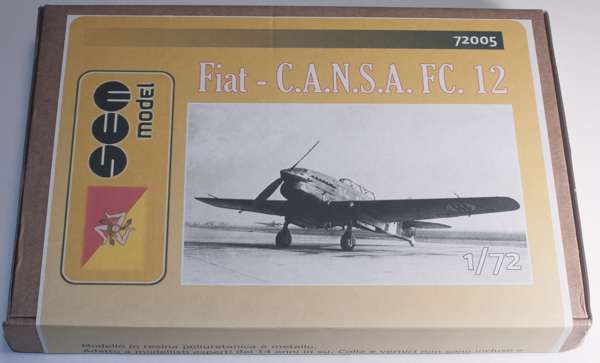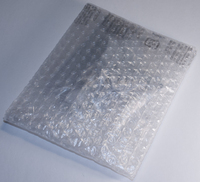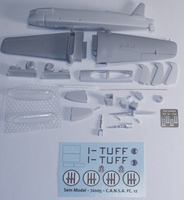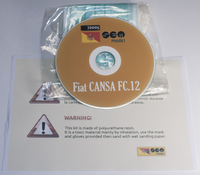
SEM Model 1/72 Fiat CANSA F.C. 12
By Matt Bittner
Introduction
The Fiat CANSA FC.12 was originally developed in the late-Thirties as a private initiative originally as a trainer utilizing out-dated parts and equipment. As a trainer, though, it was too fast and too expensive so then Fiat modified it into a dive bomber. Again, it was thought excellent in its stated purpose but for some reason the authorities decided not to persue it. Only one example was built.
The Kit
 The SEM Model 1/72 Fiat CANSA FC.12 consists of 23 pieces of gray resin, two white-metal main landing gear legs, a photoetch fret for the oleo scissors, two vacuum-formed canopies (one "just in case") a length of brass rod and a length of white, plastic sprue. Decals - nicely printed and appear to be in register - are for the dive-bomber version of the FC.12, marked in its civilian registration "I-TUFF".
The SEM Model 1/72 Fiat CANSA FC.12 consists of 23 pieces of gray resin, two white-metal main landing gear legs, a photoetch fret for the oleo scissors, two vacuum-formed canopies (one "just in case") a length of brass rod and a length of white, plastic sprue. Decals - nicely printed and appear to be in register - are for the dive-bomber version of the FC.12, marked in its civilian registration "I-TUFF".
The fuselage is a single piece with a hollowed out cockpit. To that cockpit is added two instrument panels, two control sticks and two seats. There are no color call-outs so I suspect the cockpit would be the same gray-green used on other Italian WW2 aircraft. Once the cockpit is finished and painted then the top of the fuselage is added.
 Now construction moves to adding the flying surfaces. The reason SEM included brass rod is because this is to be used to adhere the tail control surfaces to the non-moveable parts. Doing this you'll be able to pose them realistically if so desired.
Now construction moves to adding the flying surfaces. The reason SEM included brass rod is because this is to be used to adhere the tail control surfaces to the non-moveable parts. Doing this you'll be able to pose them realistically if so desired.
The major part of construction, though, will be adding the wings. It's my opinion that SEM thought the wing assembly would be a "tongue and groove" type affair but later realized they would lose cockpit area if so doing. So the "tongue" on the wing halves need to be removed, and now that's where the piece of white sprue comes in. Unfortunately the instructions don't tell you where to drill the hole in the wing for the piece of sprue. According to email direct from SEM, though, the hole is to be 2mm in diameter, 9mm away from the wing's leading edge (the hole already exists on the fuselage halves).
 Once all the pieces are on then painting can commence. It will take awhile to paint, though, because there are a lot of colors and they're all soft-edged. Another unfortunate is SEM doesn't provide any kind of profile to help with painting. What they do provide are some "real" photos on their instructional CD that could help. This is an area, especially with this particular model, I wish SEM would have provided just a bit more to help with the painting. They do provide a color "chart" in the PDF for which paints will be good for specific Italian colors, but nothing on what colors are used on the FC.12.
Once all the pieces are on then painting can commence. It will take awhile to paint, though, because there are a lot of colors and they're all soft-edged. Another unfortunate is SEM doesn't provide any kind of profile to help with painting. What they do provide are some "real" photos on their instructional CD that could help. This is an area, especially with this particular model, I wish SEM would have provided just a bit more to help with the painting. They do provide a color "chart" in the PDF for which paints will be good for specific Italian colors, but nothing on what colors are used on the FC.12.
Conclusion
Even with the short-sightings of the instructions this is still an excellent kit to pick up. You may have to look out for gaps where the wings meet the fuselage and the upper fuselage piece, but otherwise this shouldn't be a difficult build. And as far as I know, this is the only 1/72 Fiat CANSA FC.12 currently on the market.
Many thanks to SEM Model for supplying the review kit.
